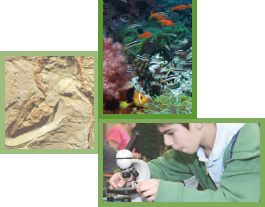The following is paraphrased from the Framework pgs. 139-141
The life sciences focus on patterns, processes, and relationships of living organisms. Life is self-contained, self-sustaining, self-replicating, and evolving, operating according to laws of the physical world, as well as genetic programming. Life scientists use observations, experiments, hypotheses, tests, models, theory, and technology to explore how life works. The study of life ranges over scales from single molecules, through organisms and ecosystems, to the entire biosphere, that is all life on Earth. It examines processes that occur on time scales from the blink of an eye to those that happen over billions of years. Living systems are interconnected and interacting. Although living organisms respond to the physical environment or geosphere, they have also fundamentally changed Earth over evolutionary time. Rapid advances in life sciences are helping to provide biological solutions to societal problems related to food, energy, health, and environment.
 From viruses and bacteria to plants to fungi to animals, the diversity of the millions of life forms on Earth is astonishing. Without unifying principles, it would be difficult to make sense of the living world and apply those understandings to solving problems. A core principle of the life sciences is that all organisms are related by evolution and that evolutionary processes have led to the tremendous diversity of the biosphere. There is diversity within species as well as between species. Yet what is learned about the function of a gene or a cell or a process in one organism is relevant to other organisms because of their ecological interactions and evolutionary relatedness. Evolution and its underlying genetic mechanisms of inheritance and variability are key to understanding both the unity and the diversity of life on Earth.
From viruses and bacteria to plants to fungi to animals, the diversity of the millions of life forms on Earth is astonishing. Without unifying principles, it would be difficult to make sense of the living world and apply those understandings to solving problems. A core principle of the life sciences is that all organisms are related by evolution and that evolutionary processes have led to the tremendous diversity of the biosphere. There is diversity within species as well as between species. Yet what is learned about the function of a gene or a cell or a process in one organism is relevant to other organisms because of their ecological interactions and evolutionary relatedness. Evolution and its underlying genetic mechanisms of inheritance and variability are key to understanding both the unity and the diversity of life on Earth.
Four core ideas reflect unifying principles in life sciences. These core ideas are essential for a conceptual understanding of the life sciences and will enable students to make sense of emerging research findings. We begin at the level of organisms, delving into the many processes and structures, at scales ranging from components as small as individual atoms to organ systems that are necessary for life to be sustained. Our focus then broadens to consider organisms in their environment—how they interact with the environment’s living (biotic) and physical (abiotic) features.
Next we consider how organisms reproduce, passing genetic information to their offspring, and how these mechanisms lead to variability and hence diversity within species. Finally, the core ideas in the life sciences culminate with the principle that evolution can explain how the diversity that is observed within species has led to the diversity of life across species through a process of descent with adaptive modification. Evolution also accounts for the remarkable similarity of the fundamental characteristics of all species.
These four core ideas, which represent basic life sciences fields of investigation—structures and processes in organisms, ecology, heredity, and evolution—have a long history and solid foundation based on the research evidence established by many scientists working across multiple fields.
Each core and component idea below is linked to the relevant section of the online Framework for K-12 Science Education: Practices, Crosscutting Concepts, and Core Ideas to provide additional background and grade band end points for each component.
